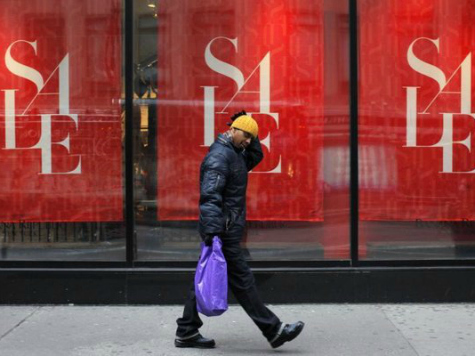
The financial press went all “rainbows, butterflies and unicorns” with headlines like “Retail Sales Sizzle in March” over the supposedly strong retail sales report just released.
Unfortunately for average Americans, their spending growth after inflation has been declining at a zero to negative one percent rate for the last two years. This has never happened after a recession since WWII and confirms that the Obama administration’s stimulus spending and the Federal Reserve’s money printing intended to create consumer demand failed. For a third of the amount of deficit spending, the federal government could have just written checks and replaced everyone’s income back to the peak year of 2007. At least this form of socialism would have kept American consumers happy.
The Commerce Department reported that retail sales excluding cars rose by 0.7% in March after what had been described by economists as a “weather-induced slump in spending in earlier months.” However, the Commerce Department also revised upward by over 100% its February “slump” report to an equally sizzling gain of 0.7% in retail consumption. On an annualized basis this would be the fastest growth in a decade, and the public should be ecstatic about the economy. Yet according to a January Fox News poll, 74% of Americans believe the nation has been in a recession for the last five years, and the “middle classes are still anxious about unemployment, the value of their homes and stagnant wages.”
Lee Adler at the Wall Street Examiner breaks down economic statistics by throwing out all the infamous “seasonal adjustment” chicanery and Obama Administration election year “happy talk” blather to discern for investors what is really happening in the U.S. economy. Adler points out the Fed’s “quantitative easing” may have been successful in making stock market speculators rich, “but as for everyone else, not so much.” He adds that while retail sales have increased, there has been “virtually no growth in US real retail spending per person after inflation since 2012 after a tepid 2009-2012 recovery.” He warns that sales after inflation are actually slowing.
The Examiner also comments that the retail sales per capita statistic is being boosted by millions of tourists that come to the U.S. to passionately shop and avoid paying the 20%+ value added retail sales tax common in Europe and Asia. If the foreign buying is backed out, “the picture would be both clearer and darker” that the “US economy is a disaster for most Americans.” He adds that after five years of “recovery,” consumer sentiment is still in a downward trend, and most Americans are doing worse.
According to Michael Burden, a principal with Excess Space Retail Services, “shoppers will likely see an average decrease in overall retail square footage of between one-third and one-half within the next five to 10 years.”
Not counting the $1.4 trillion deficit passed by the Democrat-controlled Congress in President Bush’s last year in office, President Obama in five years has run up $5.6 trillion in deficits, and the vast majority of average Americans are still miserable. I estimate for $320 billion a year or $1.6 trillion over five years, President Obama could have replaced every single dollar of income people had at the peak of the economy in 2007. The lesson here is that federal government policies turn problems into disasters.
The author welcomes feedback and will respond to comments by readers.

COMMENTS
Please let us know if you're having issues with commenting.